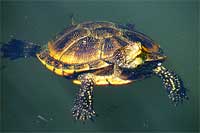European Pond Terrapins

Hi, this is Emys. I am here to welcome you all for a discussion on European Pond Terrapins today. I have been allowed to say a few words about us on this occasion.
We are here to talk and exchange our opinion about the population of European Pond Terrapins.
The situation is grave as our conservation status has been declared as ‘Near Threatened’ according to the IUCN 2.3)[1].
Emys orbicularis (Linnaeus, 1758); Yes, that is what we are named binomially by the scientists. To elaborate our classification more scientifically, we are under the Kingdom- Animalia, Phylum- Chordata, Class- Reptilia and Order- Testudines. Emydidae is our Family name which we proclaim proudly.
Now, before we go for the open dialogue, let me give you an overview about our community.
We, the European pond terrapins, inhabit the ponds and other slow-flowing water bodies like streams and marshes at various locations in Europe. Other than Europe you can see us in some places of Asia and Northern Africa.
But we avoid hot sandy areas of deserts. We were introduced into of North America and in fact a small and secured population of us exists in Australia too. We were more widely distributed during the early post-glacial era, but unfortunately, we have lost a great number of populations.
Find out more about European Pond Terrapins
 The Turtle Guide Book covers everything you could ever wish to know about terrapin care. The Turtle Guide Book covers everything you could ever wish to know about terrapin care.
Giving incredible detail on almost every subject, it is a great guide that is available as an instant download or physical paperback book delivered to your door.
Click here to read my full review |
Normally we are not very large but our length may vary from 12 cm to 38 cm according to the place of habitation. Our shells look elegant in a great combination of brown and green with some yellow specks here and there!
Shells are smooth and oval with average size of 7 to 14 inches. We have a characteristic yellow ring around our eyes and sharp nails on the webbed digits.
Our food habit is simple, we are omnivores, but if you ask about the preference, then I must mention that meat, fish, insects, worms, carrions are the things we relish with great pleasure. But at times, to avoid starvation, we nibble on vegetations too.
We are shy creatures and love to embed ourselves within the under-water mud for hibernation for at least seven months in a year. We have a long life span and can survive 30 years or more in captivity. Clutches are hatched during August and September.
We suffer from various types of parasites including some nematodes. Presently we are protected nationally in several European countries. But to increase our population, more care should be taken. What do YOU suggest my friends?

|

